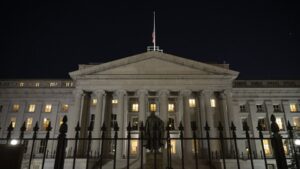Understanding the Current U.S. Fiscal Landscape: A Deep Dive into the Latest Treasury Reports
As we move through 2024, it’s clear that the landscape of the U.S. economy is complex and evolving. Recent reports from the U.S. Department of the Treasury reveal heightened challenges, characterized by a federal budget deepening in red ink and a fiscal deficit that has surged nearly 40% compared to last year. At Extreme Investor Network, we aim to provide unique insights and analysis on these critical developments, ensuring you stay ahead in the world of investments and financial planning.
A Closer Look at December’s Budget Shortfalls
In December 2024 alone, the U.S. government recorded a budget shortfall of $86.7 billion. Although this figure seems promising—a 33% decrease from the same month the year prior—it contributes to an alarming trend when we assess the quarter as a whole. The first quarter’s total deficit reached $710.9 billion, more than $200 billion higher than the previous year’s comparable figure, marking a staggering increase of 39.4%.
What’s driving this financial turmoil? Rising financing costs, persistent growth in government spending, and dwindling tax receipts are all key factors contributing to the overall increase in deficits. As citizens and investors alike, it’s vital to understand how these dynamics impact our economic future.
The Debt and Interest Burden
The national debt has officially surpassed a staggering $36 trillion, underscoring the urgency of addressing budgetary issues. Interest on the national debt alone has ballooned to $308.4 billion in fiscal 2025—up 7% from the prior year. This staggering figure indicates that the government is spending more on interest costs than on crucial categories like Social Security, defense, and health care.
Looking ahead, financing costs are projected to exceed $1.2 trillion for the full fiscal year, potentially setting another record. It’s essential for investors to consider how increasing interest rates could impact economic growth and government policies.
Trends in Treasury Yields
In the realm of treasury yields, while short-term rates have remained relatively stable, longer-term rates are on the rise. The 10-year Treasury note now yields close to 4.8%, an uptick of about 0.4 percentage points in just a month. This shift signals a changing monetary policy landscape that will influence borrowing costs for businesses and consumers alike.
For investors, these yield movements provide signals for potential investment strategies. Higher yields could mean more attractive fixed-income investments, but they also reflect heightened economic uncertainty.
Implications for Investors
These revelations from the Treasury prompt critical questions for investors. What does increasing national debt mean for future tax policies? How will rising interest rates affect your investment portfolio? Understanding these dynamics not only aids in creating an informed investment strategy but also helps in navigating an uncertain economic landscape.
At Extreme Investor Network, we are committed to providing you with timely insights and actionable strategies. By staying informed about shifts in fiscal policy, budgetary challenges, and market trends, you can position yourself to capitalize on opportunities as they arise.
In conclusion, as we analyze the current state of U.S. finances, it’s clear that both challenges and opportunities are on the horizon. By engaging with us at Extreme Investor Network, you can gain a deeper understanding of these complexities and make informed decisions that align with your financial goals. Don’t miss out—join us in navigating this intricate economic landscape together.

